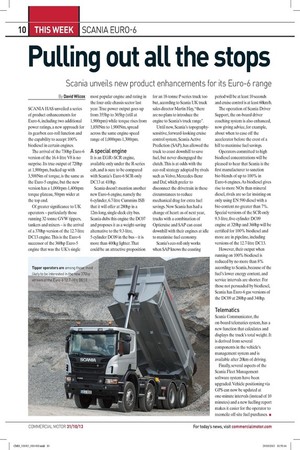Pulling out all the stops
Page 7

If you've noticed an error in this article please click here to report it so we can fix it.
Scania unveils new product enhancements for its Euro-6 range By David Wilcox
SCANIA HAS unveiled a series of product enhancements for Euro-6, including two additional power ratings, a new approach for its gearbox eco-roll function and the capability to accept 100% biodiesel in certain engines.
The arrival of the 730hp Euro-6 version of the 16.4-litre V8 is no surprise. Its true output of 720hp at 1,900rpm, backed up with 3,500Nm of torque, is the same as the Euro-5 engine, but the new version has a 1,000rpm-1,400rpm torque plateau, 50rpm wider at the top end. Of greater significance to UK operators — particularly those running 32-tonne GVVV tippers, tankers and mixers — is the arrival of a 370hp version of the 12.7-litre DC13 engine. This is the Euro-6 successor of the 360hp Euro-5 engine that was the UK's single
most popular engine and rating in the four-axle chassis sector last year. True power output goes up from 355hp to 365hp (still at 1,900rpm) while torque rises from 1,850Nm to 1,900Nm, spread across the same engine-speed range of 1,000rpm-1,300rpm.
A special engine
It is an EGR+SCR engine, available only under the R-series cab, and is sure to be compared with Scania's Euro-6 SCR-only DC13 at 410hp. Scania doesn't mention another new Euro-6 engine, namely the 6-cylinder, 6.7-litre Cummins ISB that it will offer at 280hp in a 12m-long, single-deck city bus. Scania dubs this engine the DC07 and proposes it as a weight-saving alternative to the 9.3-litre, 5-cylinder DC09 in the bus — it is more than 400kg lighter. That could be an attractive proposition
for an 18-tonne P-series truck too but, according to Scania UK truck sales director Martin Hay, "there are no plans to introduce the engine to Scania's truck range".
Until now, Scania's topographysensitive, forward-looking cruise control system, Scania Active Prediction (SAP), has allowed the truck to coast downhill to save fuel, but never disengaged the clutch. This is at odds with the eco -roll strategy adopted by rivals such as Volvo, Mercedes-Benz and Daf, which prefer to disconnect the drivetrain in these circumstances to reduce mechanical drag for extra fuel savings. Now Scania has had a change of heart: as of next year, trucks with a combination of Opticruise and SAP can coast downhill with their engines at idle to maximise fuel economy. Scania's eco-roll only works when SAP knows the coasting
period will be at least 10 seconds and cruise control is at least 60km/h.
The operation of Scania Driver Support, the on-board driver coaching system is also enhanced, now giving advice, for example, about when to ease off the accelerator before the crest of a hill to maximise fuel savings.
Operators committed to high biodiesel concentrations will be pleased to hear that Scania is the first manufacturer to sanction bio-blends of up to 100% in Euro-6 engines. As biodiesel gives rise to more NOx than mineral diesel, rivals are so far insisting on only using EN 590 diesel with a bio-content no greater than 7%. Special versions of the SCR-only 9.3-litre, five-cylinder DC09 engine at 320hp and 360hp will be certified for 100% biodiesel and more are in pipeline, including versions of the 12.7-litre DC13.
However, their output when running on 100% biodiesel is reduced by no more than 8% according to Scania, because of the fuel's lower energy content, and service intervals are shorter. For those not persuaded by biodiesel, Scania has Euro-6 gas versions of the DC09 at 280hp and 340hp.
Telematics
Scania Communicator, the on-board telematics system, has a new function that calculates and displays the truck's total weight. It is derived from several components in the vehicle's management system and is available after 20km of driving. Finally, several aspects of the Scania Fleet Management software system have been upgraded. Vehicle positioning via GPS can now be updated at one-minute intervals (instead of 10 minutes) and a new fuelling report makes it easier for the operator to reconcile off-site fuel purchases. •









































